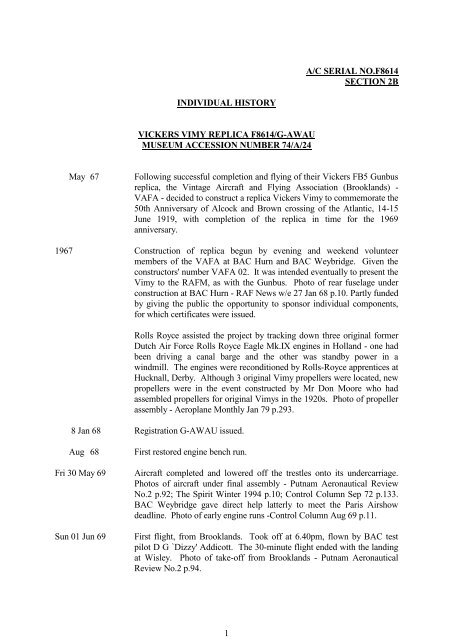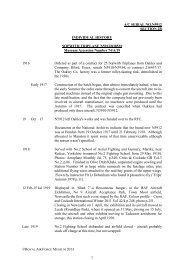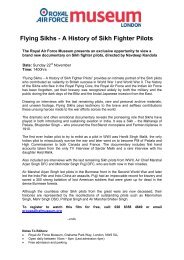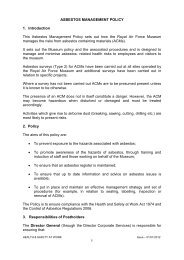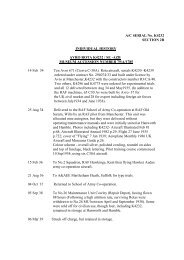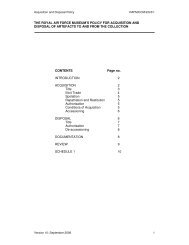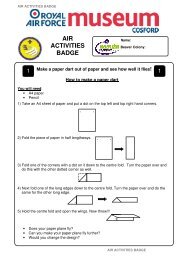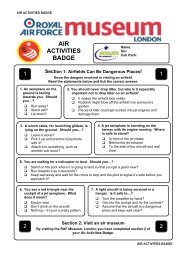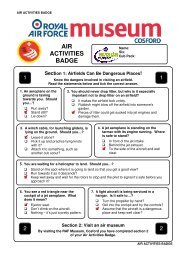Download history - Royal Air Force Museum
Download history - Royal Air Force Museum
Download history - Royal Air Force Museum
Create successful ePaper yourself
Turn your PDF publications into a flip-book with our unique Google optimized e-Paper software.
A/C SERIAL NO.F8614<br />
SECTION 2B<br />
INDIVIDUAL HISTORY<br />
VICKERS VIMY REPLICA F8614/G-AWAU<br />
MUSEUM ACCESSION NUMBER 74/A/24<br />
May 67<br />
Following successful completion and flying of their Vickers FB5 Gunbus<br />
replica, the Vintage <strong>Air</strong>craft and Flying Association (Brooklands) -<br />
VAFA - decided to construct a replica Vickers Vimy to commemorate the<br />
50th Anniversary of Alcock and Brown crossing of the Atlantic, 14-15<br />
June 1919, with completion of the replica in time for the 1969<br />
anniversary.<br />
1967 Construction of replica begun by evening and weekend volunteer<br />
members of the VAFA at BAC Hurn and BAC Weybridge. Given the<br />
constructors' number VAFA 02. It was intended eventually to present the<br />
Vimy to the RAFM, as with the Gunbus. Photo of rear fuselage under<br />
construction at BAC Hurn - RAF News w/e 27 Jan 68 p.10. Partly funded<br />
by giving the public the opportunity to sponsor individual components,<br />
for which certificates were issued.<br />
Rolls Royce assisted the project by tracking down three original former<br />
Dutch <strong>Air</strong> <strong>Force</strong> Rolls Royce Eagle Mk.IX engines in Holland - one had<br />
been driving a canal barge and the other was standby power in a<br />
windmill. The engines were reconditioned by Rolls-Royce apprentices at<br />
Hucknall, Derby. Although 3 original Vimy propellers were located, new<br />
propellers were in the event constructed by Mr Don Moore who had<br />
assembled propellers for original Vimys in the 1920s. Photo of propeller<br />
assembly - Aeroplane Monthly Jan 79 p.293.<br />
8 Jan 68 Registration G-AWAU issued.<br />
Aug 68<br />
Fri 30 May 69<br />
Sun 01 Jun 69<br />
First restored engine bench run.<br />
<strong>Air</strong>craft completed and lowered off the trestles onto its undercarriage.<br />
Photos of aircraft under final assembly - Putnam Aeronautical Review<br />
No.2 p.92; The Spirit Winter 1994 p.10; Control Column Sep 72 p.133.<br />
BAC Weybridge gave direct help latterly to meet the Paris <strong>Air</strong>show<br />
deadline. Photo of early engine runs -Control Column Aug 69 p.11.<br />
First flight, from Brooklands. Took off at 6.40pm, flown by BAC test<br />
pilot D G `Dizzy' Addicott. The 30-minute flight ended with the landing<br />
at Wisley. Photo of take-off from Brooklands - Putnam Aeronautical<br />
Review No.2 p.94.<br />
1
Wed 4 Jun 69<br />
Thus 5 Jun 69<br />
Fri 6 Jun 69<br />
An evening test flight from Wisley had to divert to land at RAF Odiham<br />
due to turbulent conditions that necessitated a large grass landing area as<br />
cross winds with no brakes and a trail skid meant a tricky landing. Photos<br />
at Odiham - RAFM photo collection P2057; <strong>Royal</strong> <strong>Air</strong> <strong>Force</strong> News w/e<br />
12 July 1969 p.3.<br />
Overnight modifications were made to the ailerons.<br />
Made three test flights from Odiham; pilot ‘Dizzy’Addicott. Photo: RAF<br />
News w/e 12 Jul 69 p.3 Took total flying hours to about five. The third<br />
flight was to obtain a special category certificate of airworthiness.<br />
Carried civil registration G-AWAU.<br />
Flown by Dizzy Addicott to the Paris <strong>Air</strong>show direct from Odiham in<br />
three hours, the Vimy's longest flight. Arrived at Le Bourget shortly after<br />
noon. Colour view - Vickers Vimy (027741) - cover. Also Aeroplane<br />
Monthly Supplement Apr 94 p.19.<br />
Sun 8 Jun 69 Flown in Flying display at Paris - Photo: Aeroplane Monthly Jun 79<br />
p.294.<br />
Mon 9 Jun 69<br />
Flown back to Wisley.<br />
9-10 Jun 69 Repainted in RAF colours as H651 at Wisley. Names `Triple First' in<br />
memory of the first Atlantic, Australia and South Africa flights by Vimys.<br />
Wed 11 Jun 69 Flown to Manchester Ringway <strong>Air</strong>port for exhibition in temporary tent -<br />
Jack Alcock had been born in Manchester. Total flying hours now 11 15<br />
hours. Photo: Putnam Aeronautical Review No.2 p.3; <strong>Air</strong> Pictorial Aug<br />
69 p.278. Photo on arrival; Friends of The Manchester <strong>Air</strong> & Space<br />
<strong>Museum</strong> Newsletter Sep 83 No 3; Great aviation Collections of Britain<br />
(Ellis) p.184.<br />
14 Jul 69 Damaged by fire at Ringway whilst being prepared to fly to the Rolls-<br />
Royce airfield at Hucknall (Derby) to show the workers there the result of<br />
their restoration work on the engines. The fire started in the leading edge<br />
of the port lower main plane just outboard of the engine, and within three<br />
minutes had spread along the whole of the upper wing destroying all<br />
fabric and damaging many wing ribs, despite the best efforts of the airport<br />
fire crews. The fire may have been started by the sun reflecting off a<br />
polished engine cowling onto the doped fabric. Photos: Aeroplane<br />
Monthly Jun 79 p.296; Flight International 24 Jul 69 p.116; Friends of<br />
The Manchester <strong>Air</strong> & Space <strong>Museum</strong> Newsletter Sep 83 No 3. The<br />
fuselage, tail and starboard lower wing were largely unaffected.<br />
04 Aug 69 CoA expired.<br />
The damaged aircraft was dismantled at Ringway and roaded back to<br />
Wisley and stored. It was decided to rebuild the aircraft to static<br />
exhibition standard for the RAF <strong>Museum</strong>. Three of the seven wing<br />
panels had to be totally replaced.<br />
2
c.Dec 70<br />
Restored components delivered to RAF <strong>Museum</strong> Hendon by No.71 MU<br />
Bicester from storage at Blackbushe (Robinson <strong>Air</strong>craft Ltd) where some<br />
wing parts had been restored, and Wisley, where the rest of the aircraft<br />
was stored.<br />
The parts were stored at Henlow by Feb 71. The propellers went to<br />
Hendon on 26 January, the mainplanes and centre sections went from<br />
Henlow to Hendon on 9 February, with other parts including engines the<br />
following day, and the ‘flying controls’ on 15 February, assembly taking<br />
place over the following week or so, recalled former RAF technician<br />
Dave Hughes in 2009.<br />
Jun 72<br />
Fully assembled in main aircraft hall at Hendon by this date and painted<br />
as F8614, a Weybridge built Vimy of 1918, still named ‘Triple First’.<br />
Photo – RAF News w/e 5 August 1972, p.15. Colour profile – Windsock<br />
Worldwide Vol 28 No.2, March/April 2012.<br />
19 Jul 73 Registration cancelled as withdrawn from use.<br />
Dec 83 Assembled in new Bomber Command Hall at Hendon. Photo: RAF<br />
Ground Support Equipment since 1918 p.57. Displayed in this location<br />
until moved into re-sited Graham White Factory building February 2003.<br />
Photo during dismantling for this move during January 2003 – Flypast<br />
March 2003 p.7. During re-assembly; Flypast April 2003 p.16.On display;<br />
Flypast March 2004 p.10; The Flying M Spring 2012 p.14.<br />
TEXT - ANDREW SIMPSON<br />
© ROYAL AIR FORCE MUSEUM 2013<br />
3


